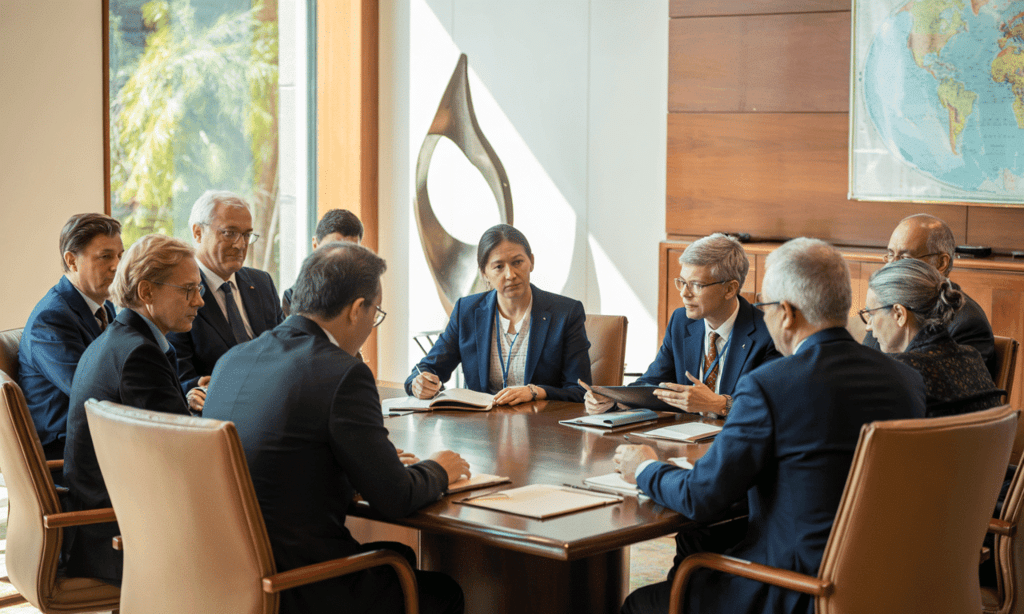Diplomatic and Consular Relations | Public International Law - CLAT PG PDF Download
Introduction
Diplomatic and consular relations govern the interactions between states through their representatives, such as ambassadors and consuls, to promote cooperation, trade, and peaceful relations. These relations are regulated by international law, primarily the Vienna Convention on Diplomatic Relations (VCDR), 1961, and the Vienna Convention on Consular Relations (VCCR), 1963. For the CLAT PG exam, understanding diplomatic and consular relations is crucial because questions often involve analyzing privileges, immunities, functions, or cases like the Tehran Hostages Case. These notes explain the topic in simple language, covering definitions, legal frameworks, functions, privileges, establishment and termination, cases, and exam tips to prepare for passage-based and theoretical questions.
Definitions and Distinctions
Diplomatic Relations
Diplomatic relations refer to formal interactions between states through diplomatic missions (e.g., embassies, high commissions) led by diplomats like ambassadors. These relations focus on high-level political, economic, and cultural cooperation.
Consular Relations
Consular relations involve interactions through consular posts (e.g., consulates) led by consuls. They focus on practical services like assisting citizens, issuing visas, and promoting trade.
Key Differences
- Purpose: Diplomatic relations handle state-to-state political matters; consular relations provide citizen services and trade support.
- Representatives: Diplomats (e.g., ambassadors) lead diplomatic missions; consuls lead consular posts.
- Location: Diplomatic missions are usually in capital cities; consular posts can be in major cities.
- Scope: Diplomatic functions are broader (e.g., treaty negotiations); consular functions are specific (e.g., passport issuance).
Examples
- An Indian ambassador in Washington, D.C., negotiates a trade agreement (diplomatic).
- An Indian consul in New York issues a visa to a U.S. citizen (consular).
Legal Framework
Overview
Diplomatic and consular relations are governed by international treaties and customary law, with the VCDR and VCCR as the primary frameworks.
Vienna Convention on Diplomatic Relations (VCDR), 1961
- Adoption: Adopted in 1961, entered into force in 1964, with 192 parties (including India).
- Purpose: Codifies rules for diplomatic missions, diplomats’ functions, and privileges.
- Key Articles:
- Article 3: Functions of diplomatic missions (e.g., representation, negotiation).
- Article 22: Inviolability of mission premises.
- Article 27: Freedom of communication.
- Article 29: Inviolability of diplomats.
- Article 31: Immunity from jurisdiction for diplomats.
- India’s Role: India ratified the VCDR and implements it through the Diplomatic Relations (Vienna Convention) Act, 1972.
Vienna Convention on Consular Relations (VCCR), 1963
- Adoption: Adopted in 1963, entered into force in 1967, with 182 parties (including India).
- Purpose: Regulates consular posts, consuls’ functions, and privileges.
- Key Articles:
- Article 5: Consular functions (e.g., assisting nationals, issuing visas).
- Article 23: Inviolability of consular premises (limited compared to diplomatic).
- Article 35: Freedom of communication.
- Article 36: Right to assist detained nationals.
- Article 41: Limited immunity for consuls.
- India’s Role: India ratified the VCCR and applies it in consular practices.
Customary International Law
- Principles like diplomatic immunity existed before the VCDR and VCCR, based on state practice.
- Customary law applies to non-parties or gaps in the conventions.
Examples
- An Indian embassy in London is protected under VCDR Article 22, preventing UK police from entering without permission.
- An Indian consul in Dubai assists an Indian citizen detained for overstaying, per VCCR Article 36.
Functions of Diplomatic and Consular Missions
Diplomatic Functions (VCDR, Article 3)
- Representation: Representing the sending state in the receiving state.
- Negotiation: Conducting talks on treaties, trade, or political issues.
- Protection: Protecting the sending state’s interests and citizens.
- Promotion: Promoting economic, cultural, and scientific relations.
- Reporting: Observing and reporting on the receiving state’s political and economic conditions.
- Example: India’s ambassador in China negotiates a border agreement and reports on China’s policies.
Consular Functions (VCCR, Article 5)
- Assisting Nationals: Helping citizens with passports, marriages, or detention.
- Issuing Visas: Granting visas to foreigners.
- Promoting Trade: Facilitating commercial and economic ties.
- Cultural Promotion: Supporting cultural exchanges and education.
- Notarial Services: Certifying documents or administering estates.
- Example: India’s consulate in San Francisco issues passports and organizes trade fairs.
Privileges and Immunities
Overview
Privileges and immunities ensure diplomats and consuls can perform their duties without interference from the receiving state. They are broader for diplomats than consuls.
Diplomatic Privileges and Immunities (VCDR)
- Inviolability of Mission Premises (Article 22): The embassy cannot be entered by the receiving state without consent.
- Inviolability of Diplomats (Article 29): Diplomats cannot be arrested or detained.
- Immunity from Jurisdiction (Article 31): Diplomats are immune from criminal, civil, and administrative jurisdiction, except in specific cases (e.g., commercial activities).
- Freedom of Communication (Article 27): Diplomatic bags and messages are inviolable.
- Tax Exemptions (Article 34): Diplomats are exempt from most taxes.
- Family Members (Article 37): Spouses and minor children enjoy similar immunities.
- Example: An Indian diplomat in France cannot be prosecuted for a traffic violation due to Article 31 immunity.
Consular Privileges and Immunities (VCCR)
- Limited Inviolability of Premises (Article 31): Consular premises are protected but can be entered in emergencies (e.g., fire).
- Limited Inviolability of Consuls (Article 41): Consuls can be arrested for grave crimes with a judicial order.
- Immunity for Official Acts (Article 43): Consuls are immune only for consular functions, not personal acts.
- Freedom of Communication (Article 35): Consular bags are protected, but can be inspected if misuse is suspected.
- Tax Exemptions (Article 49): Similar to diplomats, but more limited.
- Example: An Indian consul in Canada can be prosecuted for a personal crime but not for issuing a visa.
Key Differences
- Diplomatic immunity is broader (full criminal immunity) than consular immunity (limited to official acts).
- Diplomatic premises are fully inviolable; consular premises have exceptions.
- Diplomats cannot be arrested; consuls can be for serious crimes.
Exceptions and Waiver
- Persona Non Grata (VCDR, Article 9; VCCR, Article 23): The receiving state can declare a diplomat or consul unwelcome, requiring their recall.
- Waiver: The sending state can waive immunity, allowing prosecution (VCDR, Article 32; VCCR, Article 45).
- Abuse of Immunity: Immunity does not permit illegal acts; states may expel offenders.
Establishment and Termination of Relations
Establishment
- Diplomatic Relations (VCDR, Article 2): Established by mutual consent, often through a formal agreement or exchange of ambassadors.
- Consular Relations (VCCR, Article 2): Established by agreement, with consular posts set up in key cities.
- Appointment: The sending state appoints diplomats or consuls, but the receiving state must approve (VCDR, Article 4; VCCR, Article 12).
- Example: India and a new state agree to open embassies, appointing ambassadors after mutual approval.
Termination
- Mutual Agreement: States can end relations by consent.
- Recall or Expulsion: Diplomats or consuls can be recalled or declared persona non grata (VCDR, Article 9; VCCR, Article 23).
- Conflict or Severance: Relations may end due to war or diplomatic disputes, closing missions.
- Closure of Posts: Consular posts may close for administrative reasons.
- Example: A state expels an Indian diplomat for espionage, terminating their role.
CLAT PG Tips
- Learn the process of establishing relations (mutual consent, approval).
- Understand termination methods, especially persona non grata.
- Practice questions on the legal basis for expulsion or mission closure.
Landmark Cases
Overview
Landmark cases illustrate the application of VCDR and VCCR, critical for CLAT PG passage-based questions on diplomatic and consular law.
Key Cases
- United States Diplomatic and Consular Staff in Tehran (USA v. Iran, ICJ, 1980):
- Facts: Iranian militants seized the U.S. embassy in Tehran, taking 52 American diplomats hostage for 444 days. The U.S. sued Iran at the ICJ.
- Issue: Did Iran violate VCDR by failing to protect the U.S. embassy and diplomats?
- Judgment: The ICJ ruled that Iran breached VCDR Articles 22 (inviolability of premises) and 29 (inviolability of diplomats), holding Iran responsible for not preventing the attack and supporting the hostages’ detention.
- Significance: Reinforced the inviolability of diplomatic premises and state responsibility to protect missions, even during unrest.
- LaGrand Case (Germany v. USA, ICJ, 2001):
- Facts: Two German nationals, the LaGrand brothers, were convicted and executed in the U.S. without being informed of their right to consular assistance. Germany sued the U.S. at the ICJ.
- Issue: Did the U.S. violate VCCR Article 36 by denying consular access?
- Judgment: The ICJ ruled that the U.S. breached Article 36(1)(b), which requires informing detained foreigners of their right to consular assistance. The ICJ also held that Article 36 creates individual rights.
- Significance: Clarified the binding nature of VCCR Article 36 and the right of individuals to consular access, impacting cases involving detained foreigners.
- Avena and Other Mexican Nationals (Mexico v. USA, ICJ, 2004):
- Facts: Mexico sued the U.S. for denying consular access to 51 Mexican nationals on death row, violating VCCR Article 36.
- Issue: Did the U.S. breach its VCCR obligations, and what remedies were required?
- Judgment: The ICJ ruled that the U.S. violated Article 36 by not informing the nationals of their consular rights. The U.S. was ordered to review and reconsider the convictions.
- Significance: Reinforced the LaGrand ruling on consular access and emphasized remedies for violations, like judicial review.
- CLAT PG Tip: Study for questions on VCCR Article 36 and remedies for breaches.
- Arrest Warrant Case (DRC v. Belgium, ICJ, 2002):
- Facts: Belgium issued an arrest warrant against the DRC’s foreign minister for war crimes, despite his diplomatic immunity. The DRC sued Belgium at the ICJ.
- Issue: Did Belgium violate diplomatic immunity under customary law and VCDR?
- Judgment: The ICJ ruled that Belgium breached the minister’s immunity, as foreign ministers enjoy full immunity from foreign jurisdiction during their tenure, per customary law.
- Significance: Extended diplomatic immunity principles to high-ranking officials, clarifying their protection under international law.
Key Takeaways
- Diplomatic Relations: State-to-state interactions via embassies, governed by VCDR 1961, focusing on representation and negotiation.
- Consular Relations: Citizen and trade services via consulates, governed by VCCR 1963, focusing on assistance and visas.
- Privileges and Immunities: Diplomats have full inviolability and immunity (VCDR Articles 22, 29, 31); consuls have limited immunity for official acts (VCCR Articles 41, 43).
- Functions: Diplomatic (representation, negotiation, VCDR Article 3); consular (assistance, visas, VCCR Article 5).
- Establishment/Termination: By mutual consent; terminated via recall, expulsion, or conflict.
- Cases: Tehran Hostages (VCDR, premises), LaGrand and Avena (VCCR, consular access), Arrest Warrant (immunity).
- Exam Tips: Memorize VCDR/VCCR articles, cases, and practice applying them to scenarios and passages.
|
34 docs|13 tests
|
FAQs on Diplomatic and Consular Relations - Public International Law - CLAT PG
| 1. What are the main differences between diplomatic and consular missions? |  |
| 2. What legal framework governs diplomatic and consular relations? |  |
| 3. What are the privileges and immunities granted to diplomatic and consular missions? |  |
| 4. How are diplomatic and consular relations established and terminated? |  |
| 5. Can you provide examples of landmark cases related to diplomatic and consular law? |  |





















